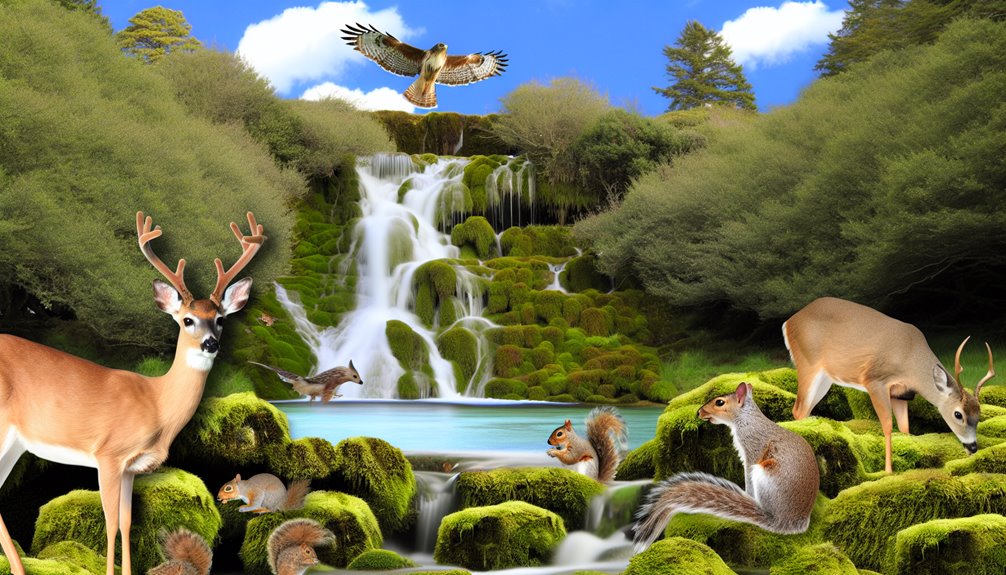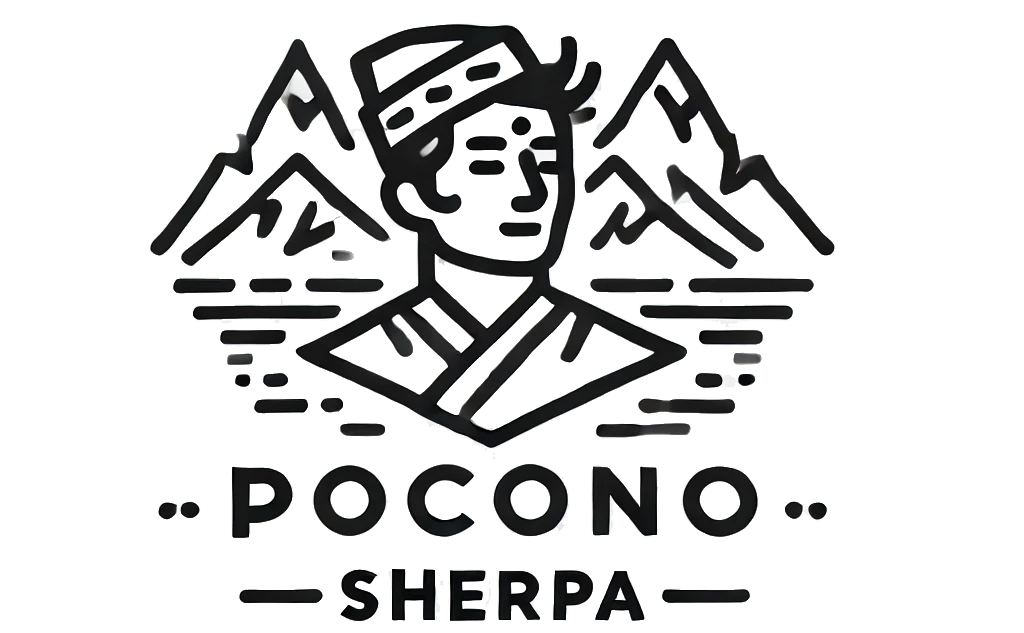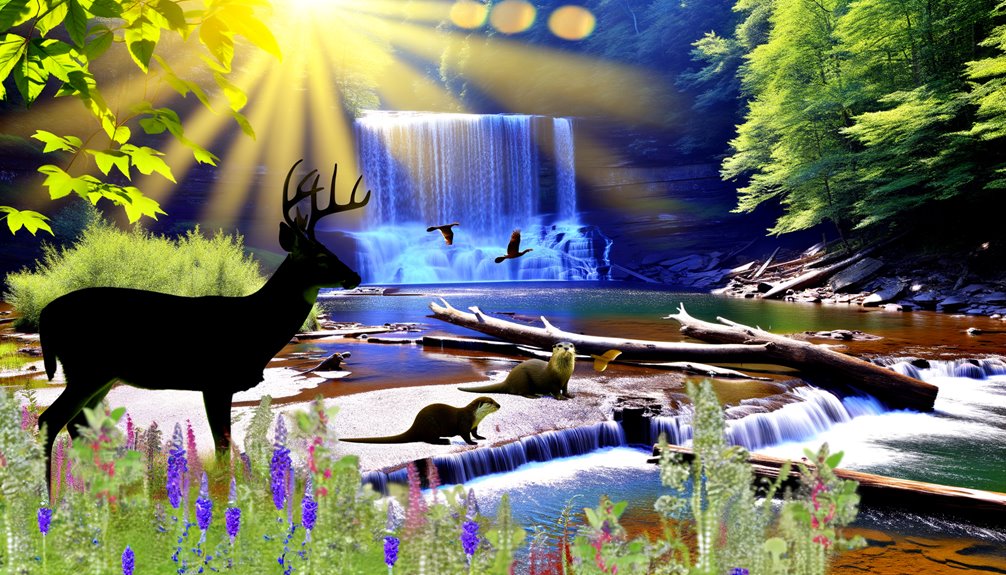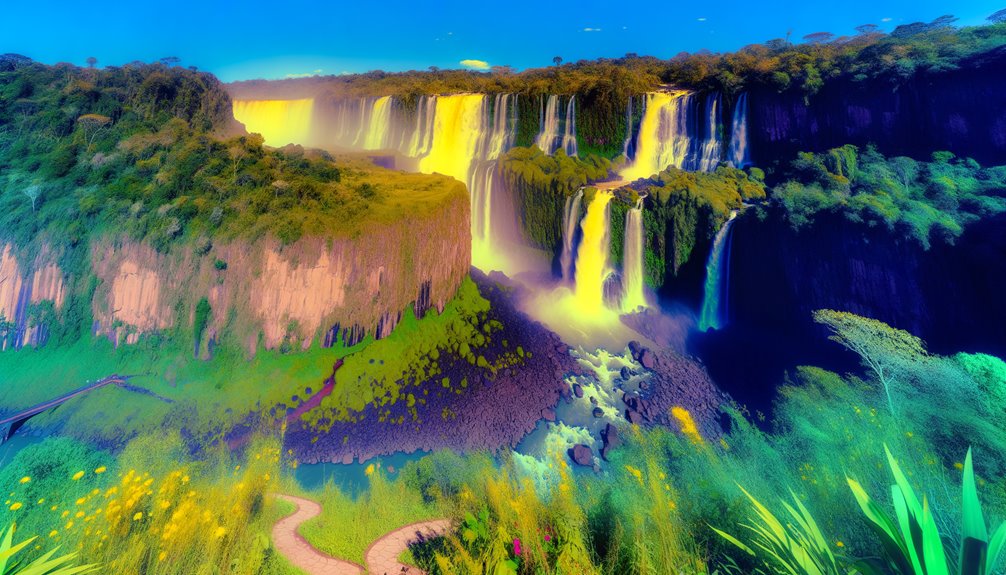Near Deer Leap Falls, you’re likely to encounter a variety of wildlife thriving in its diverse ecosystems. Keep an eye out for white-tailed deer, which are particularly active in the fall. Black bears roam the denser forests nearby, while clever coyotes and mysterious bobcats navigate the deeper woods. Down by the water, you might spot playful otters and agile minks. The riverside is a prime spot for bald eagles and ospreys, especially during nesting seasons. By observing these habitats carefully, you can enhance your wildlife experience and uncover fascinating patterns of life that exist all around you.
Habitat Overview

The habitat surrounding Deer Leap Falls showcases a remarkable interplay between geological formations and diverse ecosystems. The bedrock, dating back to the Ordovician, Silurian, and Devonian periods, reveals layers of lime, mud, sand, and gravel, all shaped by ancient Appalachian mountain-building events. As you explore the area, you’ll notice how erosion has carved out gaps and waterfalls, particularly at Deer Leap Falls, highlighting the structural weaknesses formed during geological upheavals.
Dingmans Creek, flowing east to the Delaware River, plays a significant role in shaping this habitat. Its waters contribute to a dynamic hydrological system, where streams deposit alluvium like gravel and silt, enriching the soil and supporting various plant life. The region’s temperate climate, influenced by historical glacial activities, creates seasonal variations that affect water flow and ecosystem balance. Additionally, the park is part of the Valley and Ridge Physiographic Province, which shares geologic history with regions beyond park boundaries. The Delaware Water Gap offers a unique environment that attracts a variety of wildlife, making it an ideal location for birdwatching and nature observation. In these woods, you might even glimpse the diverse species found in the Delaware Water Gap National Recreation Area.
As you hike through the rolling hills and valleys, you’ll find a mosaic of deciduous and evergreen forests, offering shelter for a multitude of species. The land, once utilized for human activities, remains an essential sanctuary for diverse ecosystems, inviting you to appreciate the intricate relationships between geology, water systems, and vegetation.
Common Wildlife Species
Exploring the diverse wildlife around Deer Leap Falls reveals a vibrant tapestry of species adapted to the unique habitats created by the area’s geological and hydrological features. You’ll likely encounter white-tailed deer gracefully moving through the woodlands, while black bears roam the denser forests. In the deeper woods, coyotes and bobcats stealthily navigate their territory, showcasing their adaptability.
The river valleys and streams teem with life as you spot otters and minks, darting through the water. Raccoons and foxes also thrive in the park’s varied environments, demonstrating the rich biodiversity here. Above, the skies are often graced by bald eagles and ospreys, their keen eyes scanning for fish near the waterfalls. During certain seasons, you may also observe nesting bald eagles in the area, adding to the remarkable wildlife experience. Additionally, the park’s diverse songbird species contribute to the symphony of sounds, enriching the overall experience for visitors.
As you explore the wetlands, you might observe frogs and turtles basking in the sun, while squirrels and downy woodpeckers make their homes in the wooded areas. During migratory seasons, look out for loons and snow geese visiting the region. Each of these species plays an essential role in the ecosystem, contributing to the rich wildlife tapestry that makes Deer Leap Falls a remarkable natural haven.
Conservation Efforts

Conservation efforts at Deer Leap Falls focus on preserving the area’s unique natural and historic features while promoting sustainable visitor experiences. Protecting both the hemlock ravine ecosystem and historic mill ruins is critical. By leaving non-hazardous downed trees in place, you help maintain the habitat’s integrity, allowing wildlife to thrive. It’s important to guarantee compliance with laws and best management practices, assuring that restoration activities align with conservation goals. The trail follows Dingmans Creek through a lush ravine, providing a scenic backdrop that enhances the visitor experience.
The maintenance of rustic trails enhances accessibility, allowing more people to enjoy the scenic amenities while minimizing ecological impact. Trained sawyers and arborists carefully select and remove hazardous trees, ensuring both safety and habitat preservation. Rebuilding trail bridges and observation platforms not only restores functionality but also enriches the visitor experience. George W. Childs Park’s reopening will further highlight the importance of these conservation efforts.
Community involvement plays a significant role in these efforts. Collaboration with local authorities and the National Park Service guarantees effective site management. Volunteers, like Trail Stewards, contribute notably by assisting with clearing and maintenance tasks. Public education on Leave No Trace principles fosters a culture of respect for nature. Each action taken reinforces the delicate balance between human visitation and wildlife protection, making Deer Leap Falls a cherished destination for both nature and history enthusiasts.
Visitor Experience
Visiting Deer Leap Falls offers a unique blend of natural beauty and historical intrigue, creating an engaging experience for all who come. The well-maintained trails, crafted by the National Park Service, guarantee accessibility for everyone, including those with handicaps. As you navigate the rustic 1.2-mile loop around Childs Park, you’ll encounter wooden steps and several bridges that span Dingmans Creek, enhancing your connection to the landscape. Additionally, the park is open daily from dawn to dusk, allowing for ample time to explore its wonders.
At the waterfall, you’ll find its impressive 30-foot height fascinating, especially with the narrow gorge at the top resembling a deer leap. The bridge at the falls’ summit provides stunning views, while another downstream bridge allows for different perspectives. Although access to the base of the falls is restricted for safety, the large, shallow pool below adds to the site’s allure. Additionally, the park features three unique waterfalls, including Factory Falls and Fulmer Falls, which further enrich your visit.
The park’s historical context, with its proximity to the ruins of a 19th-century woolen mill, adds depth to your visit. As you hike, take a moment to appreciate the beautiful scenery and the rich history that surrounds the falls, making your experience at Deer Leap truly memorable.
Nearby Wildlife Habitats

The rich tapestry of wildlife habitats surrounding Deer Leap Falls enhances the overall experience of this natural wonder. These diverse ecosystems not only support a variety of species but also provide critical ecological functions. As you explore, you’ll notice distinct habitat types that each play a unique role in sustaining wildlife.
- Forest Ecosystems: Mature oak and hickory forests shelter animals like porcupines, turkeys, and numerous bird species. Their complex structures offer food and protection. Additionally, these forests may also be home to mammals like mule deer that thrive in similar environments. Furthermore, the over 10 miles of trails in nearby areas create opportunities for wildlife observation and hiking.
- Wetlands: Areas like the Black Moshannon Bog Natural Area and beaver-created wetlands teem with specialized flora and fauna, making them essential for biodiversity.
- Mountainous Regions: Places like Blue Knob State Park provide habitats for large mammals, including black bears and wild turkeys, benefiting from elevation and varied terrain.
Each habitat around Deer Leap Falls contributes to a thriving ecosystem. The interplay between these environments guarantees that species can flourish, offering you a chance to witness nature’s intricate web of life firsthand. Whether you’re hiking through forests or observing wetlands, the nearby wildlife habitats reveal the rich ecological heritage of this remarkable area.
Seasonal Wildlife Changes
Throughout the changing seasons, wildlife near Deer Leap Falls undergoes remarkable transformations that reflect their adaptability to environmental shifts. In winter, temperature swings lead to sudden snowmelt, disrupting the hunting patterns of wolves and increasing predation risks for species like the common hare. Mild winters can awaken hibernating wildlife prematurely, leaving them vulnerable to resource scarcity.
As spring arrives, migratory birds such as the American robin shift their arrival times, often nesting earlier than before. Butterflies like the Edith’s checkerspot expand their range northward in response to rising temperatures. Meanwhile, northern cardinals are establishing themselves in areas once dominated by their southern counterparts, altering local ecosystems.
Fall sees heightened deer movement as they migrate for food and shelter. This migration can lead them into urban areas, increasing human-deer interactions. The birth of fawns in late spring guarantees their survival through careful camouflage, though mothers often leave them temporarily to forage.
Tips for Wildlife Observation

Wildlife observation near Deer Leap Falls can be an exhilarating experience, especially when you employ effective strategies to enhance your encounters. To maximize your chances of spotting wildlife, consider the following tips:
- Timing Matters: Early morning and late afternoon are prime times for wildlife activity. Animals are more likely to be on the move during these cooler periods.
- Stay Quiet and Patient: Maintain a low profile and minimize noise. Wildlife is sensitive to disturbances, so a quiet approach can yield better sightings. Patience is key; it might take time, but the reward can be thrilling.
- Know the Habitat: Familiarize yourself with the diverse ecosystems surrounding Deer Leap Falls. Understanding where specific species are likely to be found—like wetlands for amphibians or forest edges for deer—will direct your observation efforts.
Frequently Asked Questions
What Time of Day Is Best for Wildlife Viewing at Deer Leap Falls?
The best time for wildlife viewing is early morning and late afternoon. During these hours, mammals like deer and bears are most active, making your chances of spotting them higher. As day shifts to dusk, you’ll likely see birds and smaller mammals preparing for nightfall. Observing at daybreak is excellent for birdwatching, while dusk offers a chance to catch nocturnal animals like owls and raccoons. Avoid midday when many species retreat from the heat.
Are There Any Rare Species Found in the Area?
While there aren’t any extremely rare species specifically noted at Deer Leap Falls, you’ll find a diverse range of wildlife in the broader Delaware Water Gap area. You might spot migratory warblers during certain seasons, adding to the area’s charm. The unique habitats support various flora and fauna, enhancing your experience. Keep your eyes peeled for unique plants, too, as they contribute to the rich biodiversity you’ll encounter while exploring the region.
How Can I Help With Local Conservation Efforts?
You can help local conservation efforts by volunteering with wildlife refuges and parks, joining community organizations focused on environmental conservation, or participating in clean-up events. Consider donating financially to support conservation projects or sponsoring educational activities that raise awareness. Engage with your community by attending meetings, advocating for protective policies, and collaborating with neighbors to implement effective conservation strategies. Your involvement can make a significant impact on preserving local ecosystems and wildlife.
What Should I Do if I Encounter Wildlife on the Trails?
If you encounter wildlife on the trails, stay calm and keep your distance. Avoid direct eye contact, as it may provoke an animal. Make noise to alert them of your presence and back away slowly if they approach. Don’t feed or approach wildlife, even if they seem friendly. Always keep pets leashed to prevent attracting predators. Finally, report any aggressive encounters to park authorities to guarantee everyone’s safety.
Are Pets Allowed in the Park, and Can They Interact With Wildlife?
In many state parks, pets are allowed but come with strict regulations. You’ll need to keep your pet on a leash, typically no longer than 6 feet, and you must clean up after them. Interaction with wildlife is not only discouraged but can be harmful; pets can stress animals or disrupt their natural behaviors. Always check specific park rules, as some areas may prohibit pets altogether to protect local wildlife and their habitats.



